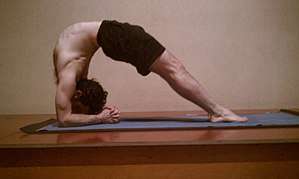Viparīta Daṇḍāsana
Viparīta Daṇḍāsana (Sanskrit: विपरीत दण्डासन) or Inverted Staff Pose is an inverted back-bending asana in modern yoga as exercise. It may be performed with both feet on the ground, or with one leg raised straight up.

Etymology and origins
The name of this pose comes from Sanskrit विपरीत viparīta, "inverted", दण्ड daṇḍa, "staff" symbolising authority and the devotee's prostration,[1] and आसन āsana, "posture" or "seat".[2][3] The variants are named for Sanskrit एक eka, "one" or द्वि dvi, "two", and पाद pada, "foot".[4]
The pose is not found in medieval Hatha yoga texts. It is described in the 20th century by two of Krishnamacharya's pupils, Pattabhi Jois in his Ashtanga Vinyasa Yoga,[5] and B. K. S. Iyengar in his Light on Yoga.[4]
Description
The pose is entered from lying on the back. The hands and feet are positioned close to the body as for upwards bow, and the body is lifted so the crown of the head can be rested on the floor. The legs are then straightened into the two-legged pose, Dvi Pada Viparīta Daṇḍāsana, and the hands are arranged holding the head as for yoga headstand (Sirsasana). Alternatively, advanced students can enter the pose from Sirsasana, arching the back, lowering the legs to the floor, and then straightening the legs.[4][6]
The one-legged pose, Eka Pada Viparīta Daṇḍāsana, can then be entered by raising one leg; the leg is held stretched straight out vertically. Advanced students can leave the pose by returning to Sirsasana.[4][7] This pose is in the Advanced A Series of Ashtanga Vinyasa Yoga.[8]
Variations
The pose can be practised on an open-backed chair, its seat padded with a folded blanket. The pose is entered by sitting with the feet through the back of the chair, holding the chair's back, and leaning back into a reclining position with the back supported on the seat of the chair. A bolster or folded blankets may be used to support the head and relax the body if the neck feels compressed.[9][6]
A more strenuous pose for advanced students is Viparīta Daṇḍāsana II, where the feet are brought towards the head until the ankles are grasped by the hands; the head is lifted. A variant of that is Eka Pada Viparīta Daṇḍāsana II, with one leg lifted to point straight up.[10]
Claims
Twentieth century advocates of some schools of yoga, such as B. K. S. Iyengar, made claims for the effects of yoga on specific organs, without adducing any evidence.[11][12] Iyengar claimed that this pose kept "the spine sound and healthy while the chest expands fully."[13]
Cautions
The pose is not advised for those with spinal injuries or high blood pressure.[2][3]
References
- Iyengar 1979, p. 373.
- "Kathryn Budig Challenge Pose: Eka Pada Viparita Dandasana I". 2012-08-06. Retrieved 2016-09-04.
- "Eka-Pada Viparita Dandasana". Ashtanga Yoga. Retrieved 2016-09-04.
- Iyengar 1979, pp. 373–379.
- Sjoman, Norman E. (1999) [1996]. The Yoga Tradition of the Mysore Palace. Abhinav Publications. pp. 100–101. ISBN 81-7017-389-2.
- Benagh, Barbara (28 August 2007). "Dwi Pada Viparita Dandasana (Two-Legged Inverted Staff Pose)". Yoga Journal.
- McCrary, Meagan (20 June 2017). "Challenge Pose: One-Legged Inverted Staff Pose". Yoga Journal.
- "Eka-Pada Viparita Dandasana". Ashtanga Yoga. Retrieved 15 December 2018.
- Mehta 1990, pp. 136-137.
- Iyengar 1979, pp. 378–379.
- Newcombe 2019, pp. 203-227, Chapter "Yoga as Therapy".
- Jain 2015, pp. 82–83.
- Iyengar 1979, p. 377.
Sources
- Iyengar, B. K. S. (1979) [1966]. Light on Yoga: Yoga Dipika. Unwin Paperbacks. ISBN 978-1855381667.CS1 maint: ref=harv (link)
- Jain, Andrea (2015). Selling Yoga : from Counterculture to Pop culture. Oxford University Press. ISBN 978-0-19-939024-3. OCLC 878953765.CS1 maint: ref=harv (link)
- Mehta, Silva; Mehta, Mira; Mehta, Shyam (1990). Yoga: The Iyengar Way. Dorling Kindersley.CS1 maint: ref=harv (link)
- Newcombe, Suzanne (2019). Yoga in Britain: Stretching Spirituality and Educating Yogis. Bristol, England: Equinox Publishing. ISBN 978-1-78179-661-0.CS1 maint: ref=harv (link)
_from_Jogapradipika_1830_(detail).jpg)
